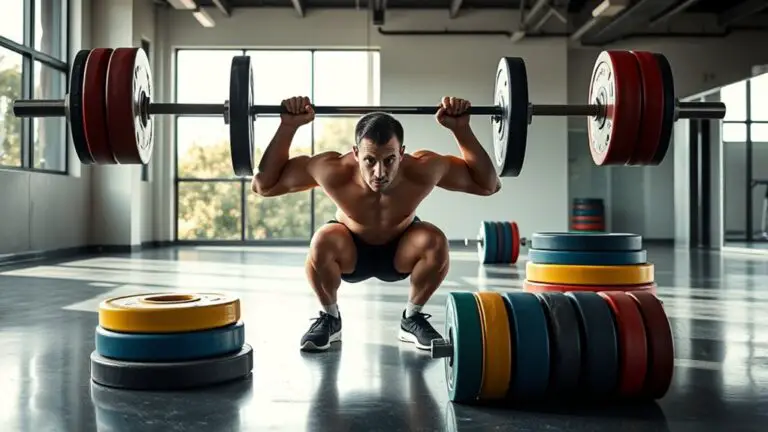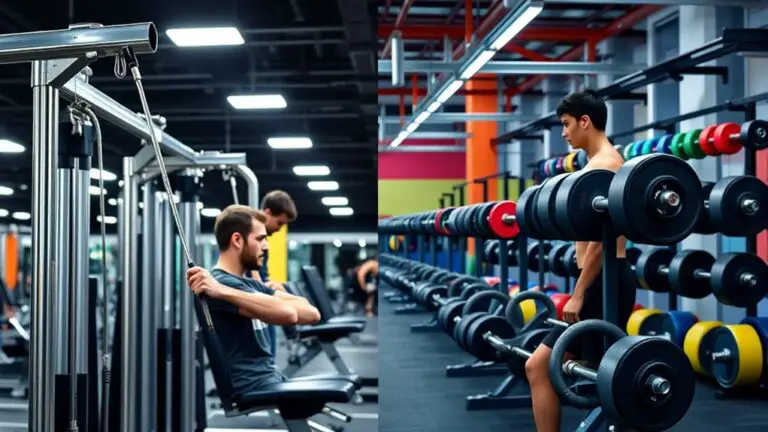Best Dumbbell Exercises for Full-Body Strength

For building full-body strength, incorporate exercises like dumbbell squats, deadlifts, bench presses, rows, and shoulder presses. Squats target your lower body, while deadlifts focus on your posterior chain. Bench presses strengthen your chest and arms, and rows are great for your upper back. Don’t forget lunges to further engage your legs and core. Each exercise can be adjusted for intensity and form. Ready to discover more variations and tips?
Dumbbell Squats

Dumbbell squats are a fantastic way to build strength in your lower body, and they can easily be incorporated into your workout routine. By holding dumbbells at your sides or resting them on your shoulders, you can increase the challenge of your squats. It’s essential to maintain proper form to guarantee safety; keep your feet shoulder-width apart and your back straight.
Experimenting with squat variations, like sumo or split squats, helps target different muscle groups while keeping your workouts fresh. Remember to engage your core throughout the movement; this not only stabilizes your body but also protects your lower back. As you lower into the squat, ascertain your knees stay in line with your toes to avoid unnecessary strain. With consistent practice and attention to form, dumbbell squats can effectively enhance your strength and stability while minimizing the risk of injury.
Dumbbell Deadlifts
Elevate your strength training routine with dumbbell deadlifts, a powerful exercise that targets your posterior chain, including the glutes, hamstrings, and lower back. This compound movement not only builds strength but also enhances your posture and stability. To guarantee safety, maintain a straight back and engage your core throughout the lift.
There are various dumbbell variations you can try, like single-leg or sumo deadlifts, which can further challenge your balance and activate different muscle groups. Start with lighter weights to master your form, gradually increasing the resistance as you become more comfortable.
The deadlift benefits extend beyond muscle development; they also improve your functional strength, making daily activities easier. Incorporating dumbbell deadlifts into your routine can lead to better athletic performance and injury prevention, so give them a try and feel the difference in your overall strength and stability!
Dumbbell Bench Press

The dumbbell bench press is a fundamental exercise that effectively targets your chest, shoulders, and triceps. To guarantee safety and maximize effectiveness, consider these tips:
- Choose the Right Weight: Start with a manageable weight to avoid strain.
- Use Proper Form: Keep your back flat and feet planted on the ground for stability.
- Incorporate Dumbbell Variations: Experiment with incline or decline presses to engage different muscle groups.
- Explore Bench Modifications: Use a stability ball or a flat bench to adapt the exercise to your level.
Always warm up before starting and consider having a spotter when lifting heavier weights. This way, you can focus on your form and reduce the risk of injury. With consistent practice and the right adjustments, you’ll build strength effectively while staying safe.
Dumbbell Rows
Rows with dumbbells are a powerful way to strengthen your upper back, shoulders, and arms. To get started, use a bent over technique, keeping your back straight and core engaged. This position helps prevent injury while allowing you to target the right muscles effectively.
You can perform single arm variations by placing one knee and hand on a bench for support. With the other hand, lift the dumbbell toward your hip, squeezing your shoulder blade at the top of the movement. This not only enhances your upper back strength but also improves stability and balance.
Remember to control the weight throughout the exercise; avoid jerking or swinging the dumbbell. Aim for 3 sets of 8 to 12 repetitions on each side, adjusting the weight as needed. Proper form is key to maximizing benefits and minimizing potential strain on your back. Happy rowing!
Dumbbell Shoulder Press

The Dumbbell Shoulder Press is a fantastic exercise for building upper body strength and stability. When done with proper form, it can enhance your shoulder muscles and improve your overall posture. Let’s explore the key benefits and techniques to guarantee you’re getting the most out of this move. Additionally, working with a personal trainer can provide expert feedback on form to ensure you’re performing the exercise safely and effectively.
Benefits of Shoulder Press
While many exercises target specific muscle groups, the dumbbell shoulder press stands out for its ability to enhance overall upper body strength. This exercise not only builds muscle but also promotes shoulder stability and effective muscle activation. Here are some key benefits:
- Improves Strength: Increases the strength of your shoulders, arms, and upper back.
- Enhances Stability: Supports shoulder stability, which is essential for daily activities and other lifts.
- Boosts Core Engagement: Engages your core, helping improve overall body stability.
- Versatile Variations: Can be performed seated or standing, allowing for adjustments based on your comfort and skill level.
Incorporating the dumbbell shoulder press into your routine can lead to significant improvements in your upper body strength and stability.
Proper Form Techniques
Achieving the right form during the dumbbell shoulder press is essential for maximizing your strength gains and preventing injuries. Start by standing or sitting with your feet shoulder-width apart, ensuring your body alignment is stable. Hold the dumbbells at shoulder height with a proper grip—palms facing forward. Keep your elbows slightly in front of your body, not flared out to the sides. As you press the weights overhead, engage your core and maintain a straight back. Avoid arching your lower back; instead, focus on a controlled motion. Lower the weights back to shoulder height without dropping them suddenly. Remember, quality over quantity is key; listen to your body and adjust the weights as needed to maintain proper form.
Dumbbell Lunges
Lunge forward with a pair of dumbbells in hand to elevate your strength training routine. Dumbbell lunges are a fantastic way to build muscle and improve balance, and they come with numerous lunge benefits. To guarantee safety and maximize effectiveness, consider these variations:
- Forward Lunges: Step straight ahead, keeping your knee behind your toes for stability.
- Reverse Lunges: Step back instead of forward, reducing knee strain and improving balance.
- Lateral Lunges: Move side to side, targeting different muscle groups and enhancing hip mobility.
- Walking Lunges: Combine steps for a dynamic movement that keeps your heart rate up.
Remember to maintain proper posture throughout your reps, engaging your core and keeping your back straight. By incorporating these lunges variations into your routine, you’ll not only enhance strength but also reduce the risk of injury. Happy lifting!
Frequently Asked Questions
How Often Should I Perform Dumbbell Exercises for Best Results?
To get the best results from your dumbbell routines, aim for 2 to 3 times per week. This frequency allows your muscles to recover while still promoting growth and strength. Make sure you’re balancing your workouts with rest days to prevent injury. It’s important to listen to your body—if you’re feeling sore or fatigued, don’t hesitate to take an extra day off. Consistency paired with safety will lead to the best outcomes.
Can Beginners Use Dumbbells Safely?
Yes, beginners can use dumbbells safely, but it’s essential to focus on dumbbell selection and proper form. Start with lighter weights to guarantee you can maintain control throughout each movement. Always pay attention to your body’s alignment and avoid rushing through exercises. Consider working with a trainer or following instructional videos to reinforce your technique. By prioritizing safety, you’ll build strength effectively while minimizing the risk of injury.
What Weight Should I Start With for Dumbbell Exercises?
When it comes to choosing the right dumbbell weight, it’s essential to follow beginner guidelines. Many believe starting with lighter weights guarantees safety and proper form. You might want to begin with 5 to 10 pounds for upper body exercises and 10 to 20 pounds for lower body movements. Listen to your body; if it feels too easy or too hard, adjust accordingly. Safety should always come first, so don’t hesitate to start light!
How Can I Prevent Injuries While Using Dumbbells?
To prevent injuries while using dumbbells, focus on maintaining proper form throughout your workouts. Make sure you’re aware of your body’s alignment and movement patterns. It’s also essential to incorporate warm-up routines before you start lifting; this prepares your muscles and joints for the workout ahead. Listen to your body, and don’t hesitate to adjust weights or take breaks if you feel any discomfort. Safety should always come first!
Are Dumbbells Better Than Barbells for Strength Training?
When considering whether dumbbells are better than barbells for strength training, you’ll find some clear advantages. Dumbbells offer greater range of motion and promote balanced muscle development, which can help prevent injuries. On the other hand, barbells can be bulkier and increase the risk of improper form, leading to potential strain. So, if safety’s your priority, you might lean towards dumbbells for a more controlled and versatile workout experience.





